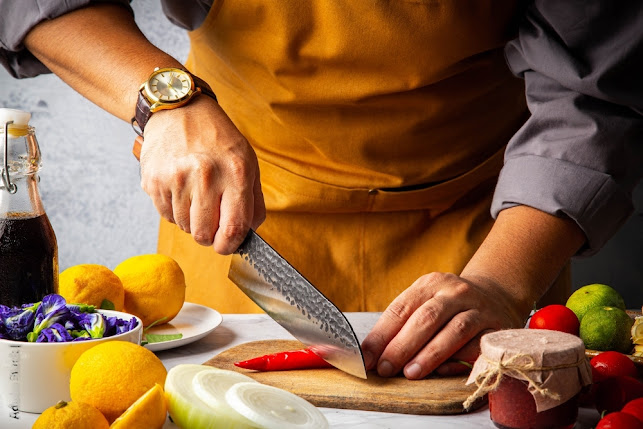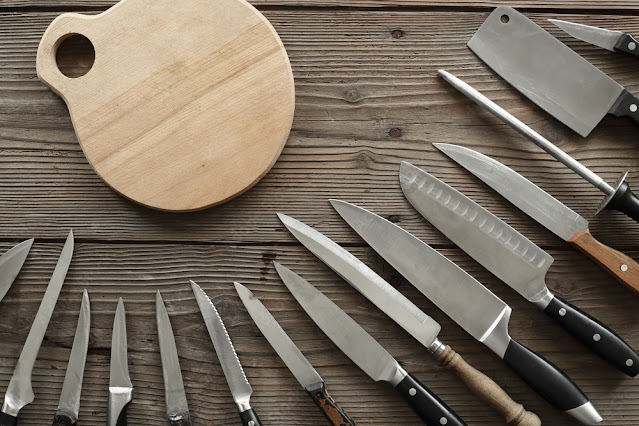"THE ART & SCIENCE OF KITCHEN KNIVES: A CUT ABOVE THE REST"
INTRODUCTION:
In the realm of culinary mastery, the kitchen knife stands as an indispensable tool that bridges the gap between a cook's vision and the plate's presentation. A well-crafted kitchen knife is not merely a utensil; it's an extension of a chef's hand, precision instrument, and a symbol of culinary expertise. From slicing and dicing to chopping and mincing, the kitchen knife is a key player in the culinary symphony. In this blog, we delve into the art and science behind kitchen knives, exploring their types, construction, maintenance, and the role they play in elevating your cooking experience.
1.TYPES OF KITCHEN KNIVES:
The world of kitchen knives is a diverse landscape, with each type designed for specific tasks. Chef's knives, with their versatile curved blades, are the workhorses of the kitchen, capable of chopping, slicing, and dicing with ease. Paring knives handle delicate tasks like peeling and intricate detail work. Serrated knives make light work of slicing through bread and delicate fruits without squishing them. The boning knife is tailored for separating meat from bones, while the Santoku knife excels in precision cutting and thin slicing.
2.THE SCIENCE OF CONSTRUCTION:
Crafting the perfect kitchen knife involves a meticulous blend of metallurgy, design, and engineering. High-quality kitchen knives are often constructed from stainless steel, carbon steel, or a combination of both. Stainless steel offers durability and corrosion resistance, while carbon steel boasts exceptional sharpness and edge retention. The art lies in the creation of a balanced blade that tapers to a razor-sharp edge while maintaining the necessary weight for controlled cutting.
A blade's tang – the extension of the blade into the handle – greatly influences balance and stability. Full tang knives, where the blade extends through the handle, provide enhanced durability and control. Forged knives, made from a single piece of metal that's been heated and shaped, are revered for their strength. On the other hand, stamped knives are cut from sheets of metal and offer affordability without compromising too much on performance.
3.MAINTENANCE & CARE:
Owning a kitchen knife is a commitment to proper maintenance. A sharp blade is not only safer to use but also more efficient in its cutting. Regular honing with a honing rod realigns the blade's edge, while periodic sharpening ensures optimal cutting performance. Proper storage is equally vital – a knife block or magnetic strip keeps blades protected and within easy reach. Washing and drying knives by hand prevents damage from harsh detergents and moisture.
4.THE ROLE IN ELEVATING COOKING EXPERIENCE:
A kitchen knife isn't just a utensil; it's an accomplice in transforming raw ingredients into culinary masterpieces. The right knife minimizes effort, enhances precision, and contributes to the overall cooking experience. The satisfying "swish" sound of a well-balanced knife effortlessly slicing through an onion, the precision of a perfectly diced pepper – these moments are where the art and science of kitchen knives truly shine.
CONCLUAION:
In the realm of cooking, the kitchen knife reigns supreme as a tool that marries artistry with scientific precision. From its diverse types catering to specific tasks to the intricate construction techniques that balance strength and sharpness, the kitchen knife is a testament to human craftsmanship and ingenuity. Proper maintenance ensures that this culinary companion remains a cut above the rest, elevating both your dishes and your cooking experience. So, whether you're a professional chef or a home cook, remember that behind every exceptional dish is a well-crafted kitchen knife ready to slice, dice, and mince its way into gastronomic greatness.















0 Comments